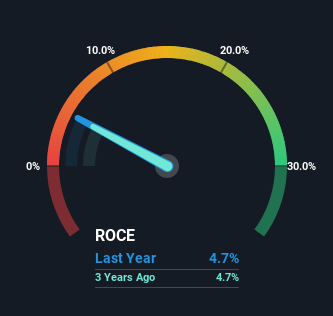- United States
- /
- Electric Utilities
- /
- NasdaqGS:LNT
Alliant Energy (NASDAQ:LNT) Hasn't Managed To Accelerate Its Returns

If we want to find a potential multi-bagger, often there are underlying trends that can provide clues. Firstly, we'll want to see a proven return on capital employed (ROCE) that is increasing, and secondly, an expanding base of capital employed. Basically this means that a company has profitable initiatives that it can continue to reinvest in, which is a trait of a compounding machine. Having said that, from a first glance at Alliant Energy (NASDAQ:LNT) we aren't jumping out of our chairs at how returns are trending, but let's have a deeper look.
What Is Return On Capital Employed (ROCE)?
Just to clarify if you're unsure, ROCE is a metric for evaluating how much pre-tax income (in percentage terms) a company earns on the capital invested in its business. To calculate this metric for Alliant Energy, this is the formula:
Return on Capital Employed = Earnings Before Interest and Tax (EBIT) ÷ (Total Assets - Current Liabilities)
0.047 = US$892m ÷ (US$21b - US$1.9b) (Based on the trailing twelve months to September 2023).
Thus, Alliant Energy has an ROCE of 4.7%. On its own, that's a low figure but it's around the 4.4% average generated by the Electric Utilities industry.
Check out our latest analysis for Alliant Energy

In the above chart we have measured Alliant Energy's prior ROCE against its prior performance, but the future is arguably more important. If you'd like, you can check out the forecasts from the analysts covering Alliant Energy here for free.
The Trend Of ROCE
The returns on capital haven't changed much for Alliant Energy in recent years. Over the past five years, ROCE has remained relatively flat at around 4.7% and the business has deployed 38% more capital into its operations. Given the company has increased the amount of capital employed, it appears the investments that have been made simply don't provide a high return on capital.
What We Can Learn From Alliant Energy's ROCE
As we've seen above, Alliant Energy's returns on capital haven't increased but it is reinvesting in the business. And investors may be recognizing these trends since the stock has only returned a total of 25% to shareholders over the last five years. As a result, if you're hunting for a multi-bagger, we think you'd have more luck elsewhere.
Since virtually every company faces some risks, it's worth knowing what they are, and we've spotted 2 warning signs for Alliant Energy (of which 1 is concerning!) that you should know about.
While Alliant Energy may not currently earn the highest returns, we've compiled a list of companies that currently earn more than 25% return on equity. Check out this free list here.
New: Manage All Your Stock Portfolios in One Place
We've created the ultimate portfolio companion for stock investors, and it's free.
• Connect an unlimited number of Portfolios and see your total in one currency
• Be alerted to new Warning Signs or Risks via email or mobile
• Track the Fair Value of your stocks
Have feedback on this article? Concerned about the content? Get in touch with us directly. Alternatively, email editorial-team (at) simplywallst.com.
This article by Simply Wall St is general in nature. We provide commentary based on historical data and analyst forecasts only using an unbiased methodology and our articles are not intended to be financial advice. It does not constitute a recommendation to buy or sell any stock, and does not take account of your objectives, or your financial situation. We aim to bring you long-term focused analysis driven by fundamental data. Note that our analysis may not factor in the latest price-sensitive company announcements or qualitative material. Simply Wall St has no position in any stocks mentioned.
About NasdaqGS:LNT
Alliant Energy
Operates as a utility holding company that provides regulated electric and natural gas services in the United States.
Proven track record average dividend payer.
Similar Companies
Market Insights
Community Narratives



